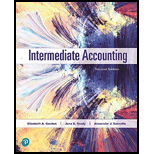
Intermediate Accounting (2nd Edition)
2nd Edition
ISBN: 9780134730370
Author: Elizabeth A. Gordon, Jana S. Raedy, Alexander J. Sannella
Publisher: PEARSON
expand_more
expand_more
format_list_bulleted
Question
Chapter 15, Problem 2BCC
a.
To determine
Explain the way in which FASB is decided to split the exposure draft into two final standards.
b.
To determine
Explain the reasons of FASB decided to make SFAS No. 129 to non publicentities.
c.
To determine
Explain the reasons of FASB decided to include securities which do not impact the computation of EPS.
Expert Solution & Answer
Want to see the full answer?
Check out a sample textbook solution
Students have asked these similar questions
Superior Manufacturing uses a predetermined overhead rate based on direct labor hours to allocate manufacturing overhead to production jobs. For 2024, the company's budget includes estimated manufacturing overhead of $720,000 and estimated direct labor hours of 20,000. In March, the production department completed Job #304, which required $8,200 in direct materials and $4,500 in direct labor (representing 250 hours at $18 per hour). The cost accountant needs to determine the predetermined overhead rate, the manufacturing overhead allocated to Job #304, and the total cost of this job.
Hi experts please provide answer this accounting question
Please explain this financial accounting problem with accurate financial standards.
Chapter 15 Solutions
Intermediate Accounting (2nd Edition)
Ch. 15 - Prob. 15.1QCh. 15 - What are the retained earnings of a firm?Ch. 15 - Prob. 15.3QCh. 15 - Prob. 15.4QCh. 15 - Does an entity have to legally dissolve treasury...Ch. 15 - Prob. 15.6QCh. 15 - Prob. 15.7QCh. 15 - Prob. 15.8QCh. 15 - Prob. 15.9QCh. 15 - Prob. 15.10Q
Ch. 15 - Prob. 15.11QCh. 15 - Do firms often use stock dividends to avoid...Ch. 15 - Prob. 15.13QCh. 15 - What is included in other comprehensive income?Ch. 15 - Is a specific format required for reporting...Ch. 15 - Prob. 15.16QCh. 15 - Boone Corporations outstanding capital stock on...Ch. 15 - Prob. 15.2MCCh. 15 - Prob. 15.3MCCh. 15 - Prob. 15.4MCCh. 15 - Prob. 15.5MCCh. 15 - Prob. 15.6MCCh. 15 - Prob. 15.7MCCh. 15 - Prob. 15.1BECh. 15 - Stockholders Equity Terminology, U.S. GAAP, IFRS....Ch. 15 - Common Stock Issuance, No Par Value. Perdido...Ch. 15 - Prob. 15.4BECh. 15 - Prob. 15.5BECh. 15 - Prob. 15.6BECh. 15 - Prob. 15.7BECh. 15 - Prob. 15.8BECh. 15 - Treasury Stock Transactions. Ginger Spice...Ch. 15 - Treasury Stock Transactions. On March 15, Chief...Ch. 15 - Treasury Stock Transactions, Retirement. Using the...Ch. 15 - Prob. 15.12BECh. 15 - Prob. 15.13BECh. 15 - Prob. 15.14BECh. 15 - Common Stock Issuance, Stated Value, Issue Costs....Ch. 15 - Common Stock Issuance. Par Value, Issue Costs,...Ch. 15 - Prob. 15.3ECh. 15 - Prob. 15.4ECh. 15 - Prob. 15.5ECh. 15 - Treasury Stock Transactions, Retirement,...Ch. 15 - Treasury Stock Transactions, Disclosure. The...Ch. 15 - Treasury Stock Transactions. Several years ago,...Ch. 15 - Prob. 15.9ECh. 15 - Prob. 15.10ECh. 15 - Prob. 15.11ECh. 15 - Prob. 15.12ECh. 15 - Preferred Stock Issuance Dividends, Disclosure....Ch. 15 - Prob. 15.14ECh. 15 - Prob. 15.15ECh. 15 - Prob. 15.16ECh. 15 - Prob. 15.17ECh. 15 - Prob. 15.18ECh. 15 - Prob. 15.19ECh. 15 - Prob. 15.20ECh. 15 - Prob. 15.21ECh. 15 - Prob. 15.22ECh. 15 - Prob. 15.1PCh. 15 - Prob. 15.2PCh. 15 - Prob. 15.3PCh. 15 - Prob. 15.4PCh. 15 - Prob. 15.5PCh. 15 - Common Stock Issuance, Treasury Stock, Dividends,...Ch. 15 - Prob. 15.7PCh. 15 - Prob. 15.8PCh. 15 - Prob. 15.9PCh. 15 - Prob. 1JCCh. 15 - Judgment Case 2: Impact of Judgment in Accounting...Ch. 15 - Surfing the Standards Cases Surfing the Standards...Ch. 15 - Prob. 1BCCCh. 15 - Prob. 2BCC
Knowledge Booster
Similar questions
- Accounting problemarrow_forwardTrent Manufacturing Company produces and sells 95,000 units of a single product. Variable costs total $285,000 and fixed costs total $390,000. If each unit is sold for $11, what markup percentage is the company using?arrow_forwardWhat is the company's overhead application ratearrow_forward
- Answerarrow_forwardI am trying to find the accurate solution to this general accounting problem with appropriate explanations.arrow_forwardDavis Company reported an increase of $350,000 in its accounts receivable during the year 2023. The company's statement of cash flows for 2023 reported $980,000 of cash received from customers. What amount of net sales must Davis have recorded in 2023?arrow_forward
arrow_back_ios
SEE MORE QUESTIONS
arrow_forward_ios
Recommended textbooks for you
 Cornerstones of Financial AccountingAccountingISBN:9781337690881Author:Jay Rich, Jeff JonesPublisher:Cengage Learning
Cornerstones of Financial AccountingAccountingISBN:9781337690881Author:Jay Rich, Jeff JonesPublisher:Cengage Learning Intermediate Accounting: Reporting And AnalysisAccountingISBN:9781337788281Author:James M. Wahlen, Jefferson P. Jones, Donald PagachPublisher:Cengage LearningPrinciples of Accounting Volume 1AccountingISBN:9781947172685Author:OpenStaxPublisher:OpenStax College
Intermediate Accounting: Reporting And AnalysisAccountingISBN:9781337788281Author:James M. Wahlen, Jefferson P. Jones, Donald PagachPublisher:Cengage LearningPrinciples of Accounting Volume 1AccountingISBN:9781947172685Author:OpenStaxPublisher:OpenStax College- Century 21 Accounting Multicolumn JournalAccountingISBN:9781337679503Author:GilbertsonPublisher:Cengage
 Auditing: A Risk Based-Approach to Conducting a Q...AccountingISBN:9781305080577Author:Karla M Johnstone, Audrey A. Gramling, Larry E. RittenbergPublisher:South-Western College Pub
Auditing: A Risk Based-Approach to Conducting a Q...AccountingISBN:9781305080577Author:Karla M Johnstone, Audrey A. Gramling, Larry E. RittenbergPublisher:South-Western College Pub

Cornerstones of Financial Accounting
Accounting
ISBN:9781337690881
Author:Jay Rich, Jeff Jones
Publisher:Cengage Learning

Intermediate Accounting: Reporting And Analysis
Accounting
ISBN:9781337788281
Author:James M. Wahlen, Jefferson P. Jones, Donald Pagach
Publisher:Cengage Learning

Principles of Accounting Volume 1
Accounting
ISBN:9781947172685
Author:OpenStax
Publisher:OpenStax College


Century 21 Accounting Multicolumn Journal
Accounting
ISBN:9781337679503
Author:Gilbertson
Publisher:Cengage

Auditing: A Risk Based-Approach to Conducting a Q...
Accounting
ISBN:9781305080577
Author:Karla M Johnstone, Audrey A. Gramling, Larry E. Rittenberg
Publisher:South-Western College Pub